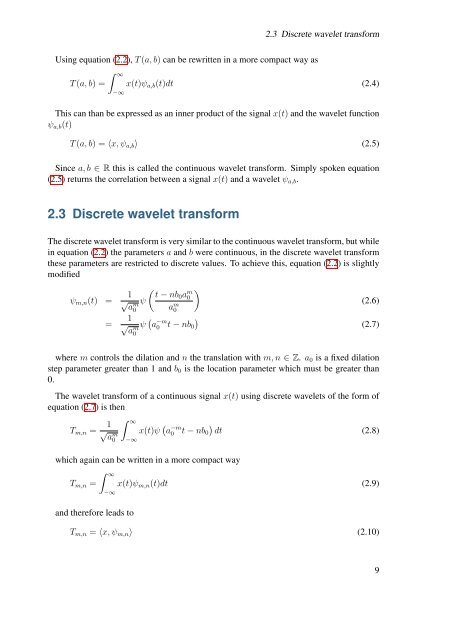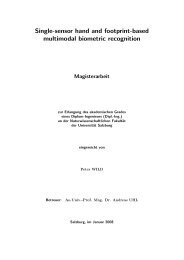Pit Pattern Classification in Colonoscopy using Wavelets - WaveLab
Pit Pattern Classification in Colonoscopy using Wavelets - WaveLab
Pit Pattern Classification in Colonoscopy using Wavelets - WaveLab
Create successful ePaper yourself
Turn your PDF publications into a flip-book with our unique Google optimized e-Paper software.
2.3 Discrete wavelet transform<br />
Us<strong>in</strong>g equation (2.2), T (a, b) can be rewritten <strong>in</strong> a more compact way as<br />
T (a, b) =<br />
∫ ∞<br />
−∞<br />
x(t)ψ a,b (t)dt (2.4)<br />
This can than be expressed as an <strong>in</strong>ner product of the signal x(t) and the wavelet function<br />
ψ a,b (t)<br />
T (a, b) = 〈x, ψ a,b 〉 (2.5)<br />
S<strong>in</strong>ce a, b ∈ R this is called the cont<strong>in</strong>uous wavelet transform. Simply spoken equation<br />
(2.5) returns the correlation between a signal x(t) and a wavelet ψ a,b .<br />
2.3 Discrete wavelet transform<br />
The discrete wavelet transform is very similar to the cont<strong>in</strong>uous wavelet transform, but while<br />
<strong>in</strong> equation (2.2) the parameters a and b were cont<strong>in</strong>uous, <strong>in</strong> the discrete wavelet transform<br />
these parameters are restricted to discrete values. To achieve this, equation (2.2) is slightly<br />
modified<br />
ψ m,n (t) =<br />
=<br />
(<br />
1 t − nb0 a m 0<br />
√ ψ a<br />
m<br />
0<br />
a m 0<br />
)<br />
1<br />
√ a<br />
m<br />
0<br />
ψ ( a −m<br />
0 t − nb 0<br />
)<br />
(2.6)<br />
(2.7)<br />
where m controls the dilation and n the translation with m, n ∈ Z. a 0 is a fixed dilation<br />
step parameter greater than 1 and b 0 is the location parameter which must be greater than<br />
0.<br />
The wavelet transform of a cont<strong>in</strong>uous signal x(t) us<strong>in</strong>g discrete wavelets of the form of<br />
equation (2.7) is then<br />
T m,n = 1 √ a<br />
m<br />
0<br />
∫ ∞<br />
−∞<br />
x(t)ψ ( a −m<br />
0 t − nb 0<br />
)<br />
dt (2.8)<br />
which aga<strong>in</strong> can be written <strong>in</strong> a more compact way<br />
T m,n =<br />
∫ ∞<br />
−∞<br />
x(t)ψ m,n (t)dt (2.9)<br />
and therefore leads to<br />
T m,n = 〈x, ψ m,n 〉 (2.10)<br />
9








